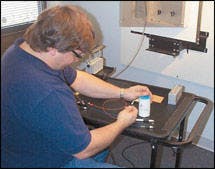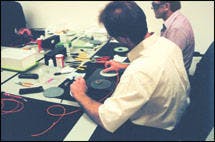Working with optical fiber can be hazardous to your health. But how many are listening?
The drive for more optical-fiber networks is prompting a call for better safety awareness. But as more copper cabling installers enter the field, many safety precautions seem to be falling by the wayside.
Many installers who work with optical fiber are familiar with important safety rules, such as:
- Always wear eye protection and be conscious of any bare fibers;
- Never look into the end of an optical-fiber cable;
- Don't wear contact lenses while working with optical fiber;
- When terminating, work against a black background so you can quickly tell if there are any stray optical fiber pieces.
But some in the industry say that even the most basic safety precautions are not being followed. "Especially in today's economy, there are not enough qualified people. They're gone," says Michael St. Angelo, IT/telecom consulting/project manager for Pennsylvania-based TEL-A-Saint.
A student at The Light Brigade practices using a fiber trap while splicing optical fiber. Analysts say installers still fail to take basic precautions when splicing.
In a worst-case scenario, optical-fiber installers who aren't safety-conscious can be killed at the job site. For example, two installers working in the midwest were conducting an aerial cable installation when they touched highly-conductive brackets to a high-voltage line. Both were killed.
They weren't alone. According to the Bureau of Labor Statistics' latest figures, 20 on-the-job deaths occurred in the United States under the category "Electronic Repairers of Communications and Industrial Equipment in 1999." (The category includes cable installers.) And while this is a relatively small number when you consider that there were 6,000 workplace deaths in 1999, industry representatives still say it points to a growing need for safety awareness and habits.
While the majority of mishaps are not fatal, there remain serious problems. Installers can use unsafe practices for disposing of fiber, such as rolling up a piece of double-sided tape and running it over the area where they just finished splicing. Or they may throw fiber shards into a company's wastebasket, where they may later be transferred to another person or become airborne.
Many safety precautions, in fact, are taken for granted. Mike Lewis, senior training specialist for AVO International Training Institute (www.avointl.com), based in Dallas, TX, says he is still amazed at how often installers will gaze into the end of a freshly spliced piece of optical fiber.
An installation student at the BICSI training center practices splicing optical fiber while using safety glasses, a fiber disposal container, tweezers and a black work surface.
"People do that-you'd be surprised," says Lewis. "They can't see the light, but it's there. They point that light toward their eyes, and the laser can be hazardous and cause damage."
Carl Mock, assistant administrator for telephone services at Space and Warfare Command in Pensacola, FL, says installers still fail to take enough precautions to dispose of tiny shards of optical fiber glass.
"If you get it in your eye, you are going to the hospital, like it or not," says Mock.
St. Angelo points out that most of the safety problems related to optical fiber installations occur when installers mishandle the fiber during splicing operations. But he says, "A lot of the concerns of the past are gone. There is very little activity anymore with the ends of fibers as far as polishing is concerned. It's migrating to a more mechanical connector where you don't have to polish or handle the ends, and as that migration occurs, the safety threat is reduced greatly."
Still, some end-users say they expect installers to have millions of dollars' worth of liability insurance before they take on an optical-fiber cabling job. Darrell Henderson, district manager for Branch Banking & Trust based in Winston-Salem, NC, says his company takes careful steps to make sure installers have liability insurance. "Most of the time, we are not liable and require that all wiring vendors have $1 million worth of liability insurance," says Henderson. "If something happens, it would be their fault, but the bank could be sued for their negligence."
Meanwhile, safety techniques are not always enforced and practiced at job sites.
"I'll put it this way. The knowledge and enforcement of them are the two weak points," says St. Angelo. "When you think of the codes that regard safety, I don't think they are taught enough. They are not enforced internally."
"Very few people pay attention to safety," St. Angelo continues. "And what is the penalty for this? Until you get caught or hurt, there is very little penalty."
The training glitch
St. Angelo says safety lapses can be largely tied to faulty training courses, especially for electricians attempting to cross over to the data field. Too many times, he says, these courses fail to emphasize safety steps.
Others put blame on the instructors.
"I've sat in classes and watched what's going on, and seen instructors who have fibers flying all over the place, and yet they are not wearing safety glasses," says Jim Hayes, principal engineer for Fiber Optic Test Equipment Co. (www.fotec.com) based in Medford, MA. "The students pick up these issues from the instructor. The instructor must set the standard for the students."
But some says it's because the students are not paying attention. They take for granted just how sharp a piece of optical fiber can be, and aren't careful to make sure it is disposed of correctly.
"In class, one fellow didn't and later said, 'I should have,'" says Eric Pearson, president of Pearson Technologies Inc., an optical-fiber training center based in Acworth, GA. "He said, 'I went home and my wife jumped into my lap and we both found a piece of fiber.'"
Sadly, St. Angelo says it isn't hard to find examples of poor safety habits in optical-fiber installation. He even points to cable installers now working at the Pentagon trying to repair damage left by the Sept. 11, 2001 terrorist attacks.
"If you poll a group of people in the Pentagon, you'll find they bring them in and work them 12 hours a day. And who knows what safety training they've had?" St. Angelo says. "There is so much consulting going on, nobody has any visibility on the employee anymore."
Can you say 'ouch'?
But not all installation safety concerns fall on the optical fiber side. Installers can get hurt installing copper cable as well. "You've got between 23- and 25-gauge copper wiring that will jam under your fingernails, and it hurts," says Mock. "If you punch it down, it can come up and hit you in the eye."
And those who work with copper have to be wary of being exposed to electricity. Today's installers need to wear rubber gloves, as well as hard hats. Copper cable in stallers should be conducting pre-surveys before each job that will show them how to limit their exposure to any safety hazards.
"Some people are aware of the hazards, but with so much fiber work going on in today's environment, there is a lot being taken for granted," says Lewis. "I don't think they're paying as much attention as they should be."
Deadlines are a factor, too. "I know there is a pressure to get the job done that is basically not spoken," Mock continues. "It comes down to this. If you can finish a day early by doing something, it will make money for the boss. And if they want to get the job done, sometimes a blind eye is turned when unsafe practices are made."
Making the change
Many agree that the more worrisome safety problems are coming from an increased demand for optical-fiber networks. The problems began mounting as installers who were used to working with copper fiber made quick career changes.
"Right now, there is a crossover of people doing copper and then going to fiber without training," says Bob Hickey, a contract trainer for FOTEC. "They more or less watch someone do it, or read a book. And some of the safety factors are overlooked in that."
Bill Woodward, senior engineer for W R Systems LTD, says today's installers need to take safety seriously, even if they are working with very basic materials and tools.
Bill Miller, marketing manager for Claus Tools (www.claussco.com) based in Fremont, OH, says the problem is that the training isn't keeping up with the percentage of people getting into the business. Installers, consequently, are resorting to installation methods that worked with copper cable, but became problematic when applied to optical fiber.
"The unfortunate thing is we are finding people aren't getting the safety message," says Miller.
St. Angelo says that to get to a reasonable level of training today, the installer should undertake at least three months' worth of classes. But "we are not developing these people, they are not to be found. People are throwing them on the job, and they are expected to learn in five minutes."
Bill Woodward, senior engineer for WR Systems LTD (www.wrsystems.com), based in Fairfax, VA, says installers need to take safety seriously, even if they are working with very basic materials and tools. He recalls how one day one of his students was cutting Kevlar with a pair of shears. "This guy was not paying attention in class one day, and as he cut the Kevlar, the shears went between his thumb and index finger," Woodward says. "He sliced his hand wide open."
St. Angelo adds that increasingly, installers must be familiar with products from multiple manufacturers, and have an understanding of fire alarm and sprinkler systems, core drilling, and termination and crimping techniques.
"All of this work and the impact of safety techniques is lost on the person," says St. Angelo. "They get their hands and fingers caught in the wrong thing, and a person gets hurt."
Lewis agrees, but says there is an answer. New developments in technology that involve fusion splicing, mechanical splicing and test equipment call for greater safety awareness, which has prompted him to constantly introduce new techniques and safety procedures. Other training courses need to do the same, he says.
"Our class is constantly upgrading, with new procedures coming out that we incorporate into our training," says Lewis. "We've got new equipment constantly on the market, with upgrades from previous versions."
Brian Milliganis Senior Associate Editor for Cabling Installation & Maintenance.


